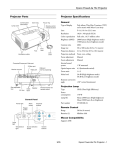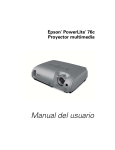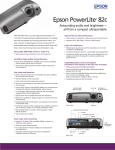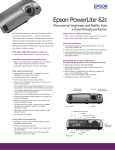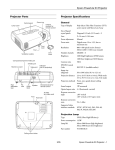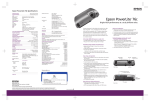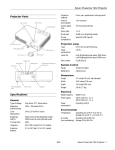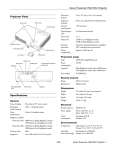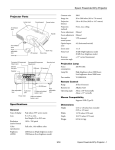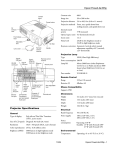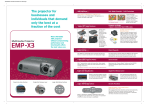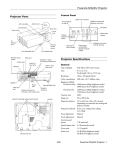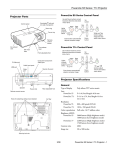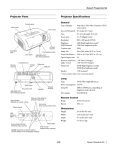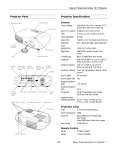Download Epson PowerLite 82c Specifications
Transcript
Epson PowerLite 62c/82c Projector Remote Control Buttons Projector Parts Control panel (see below) Security lock Zoom ring reduces the zoomed image Focus ring zooms in on (enlarges) selected area Selects menu items and settings, and scrolls the image Remote control sensor Lamp cover Selects a menu option or displays the next screen or menu Cancels current function or displays previous menu or screen Foot release lever Front adjustable foot Turns projector on or off Turns off audio and video Lens cap Freezes the current image Air exhaust vent Computer/Component Video ports and related audio ports S-Video port Video port Selects computer or component video source USB port for wireless mouse Remote control sensor Displays or hides projector menus Speaker Selects S-Video source Power Audio Out port inlet Rear adjustable foot Monitor Out port Adjusts computer images to the optimum settings Video/S-Video audio ports RS-232 port Selects a color mode Selects Video source Changes the aspect ratio from 4:3 to 16:9 Control Panel Power light Menu button Power button Keystone buttons Projector Specifications Esc button General Enter button Lamp light Temperature light Source Search button Volume buttons Help button 9/05 Type of display Poly-silicon Thin Film Transistor (TFT) active matrix with Micro Lens Array Lens F=1.6, 18.4 to 22.12 mm Resolution 82c: 1024 × 768 pixels (XGA) 62c: 800 × 600 pixels (SVGA) Color reproduction Full color, 16.77 million colors Brightness (ANSI) 2000 lumens (High brightness mode) 1500 lumens (Low brightness mode) Contrast ratio 400:1 Image size 30 to 300 inches (0.8 to 7.6 meters) Projection distance 2.8 to 35.4 feet (0.9 to 10.8 meters) Projection methods Front, rear, ceiling Focus adjustment Manual Epson PowerLite 62c/82c Projector - 1 Epson PowerLite 62c/82c Projector Altitude Up to 4,921 feet (1,500 m) in standard operating mode, or up to 7,500 feet (2,286 m) with high altitude fan mode enabled Zoom adjustment Manual (optical) Internal sound system 5 W monaural Optical aspect ratio 4:3 (horizontal:vertical) Zoom ratio 1:1.2 Safety Noise level 36 dB (High brightness mode) 30 dB (Low brightness mode) United States FCC 47CFR Part 15B Class B (DoC) UL60950 Third Edition Canada ICES-003 Class B CSA C22.2 No. 60950 (cUL) CE Marking Keystone correction angle Automatic ± 30° vertical (maximum) Type UHE (Ultra High Efficiency) Directive 73/23/EEC, 89/336/EEC IEC 60950 Third Edition EN 55022, EN 55024 Power consumption 170 W Pixelworks™ DNX™ ICs are used in this projector. Projection Lamp Lamp life About 2000 hours (High brightness) About 3000 hours (Low brightness) Part number V13H010L34 Compatible Video Formats You can use any of the following video sources: VCR, DVD player, camcorder, digital camera, gaming console, or laser disc player. The projector supports composite video, S-Video, component video, and RGB video, and it automatically senses the video format (HDTV, SDTV, NTSC, PAL, or SECAM). Remote Control Range 20 feet (6 meters) Batteries (2) Alkaline AAA The projector supports the following international video standards. Mouse Compatibility Supports USB Dimensions Height 3.4 inches (86 mm) 3.9 inches (98 mm) with feet extended Width 12.9 inches (327 mm) Depth 9.7 inches (246 mm) Weight 5.9 lb (2.7 kg) Electrical Rated frequency 50/60 Hz Power supply 100 to 120 VAC, 2.9 A 200 to 240 VAC, 1.2 A Power consumption Operating: 250 W Standby: 4 W Environmental Temperature (non-condensing) Operating: 41 to 95 °F (5 to 35 °C), Storage: 14 to 140 °F (–10 to 60 °C) Humidity (non-condensing) Operating: 20 to 80% RH Storage: 10 to 90% RH 2 - Epson PowerLite 62c/82c Projector 9/05 Mode Refresh rate (Hz) NTSC NTSC 4:3 PAL M-PAL N-PAL PAL60 SECAM 60 60 50 60 50 60 50 TV525i TV625i SDTV480p SDTV480p HDTV720p HDTV720p HDTV1080i HDTV1080i 60 50 60 50 60 50 60 50 Epson PowerLite 62c/82c Projector Compatible Computer Display Formats Positioning the Projector To project images from a computer, set the computer’s video card at a refresh rate (vertical frequency) compatible with the projector; see the following table for compatible formats. Some images are automatically resized to display in the projector’s “native” format (XGA). The frequencies of some computers may not allow images to display correctly; see your computer’s documentation for details. Mode Refresh r ate (Hz) Resolution VGA EGA 70 640 × 350 VGA—60 VESA—72 VESA—75 VESA—85 60 72 75 85 640 × 480 640 × 480 640 × 480 SVGA—56 SVGA—60 SVGA—72 SVGA—75 SVGA—85 56 60 72 75 85 800 × 600 800 × 600 800 × 600 800 × 600 800 × 600 XGA—60 XGA—70 XGA—75 XGA—85 60 70 75 85 1024 × 768 1024 × 768 1024 × 768 1024 × 768 SXGA1—70 SXGA1—75 SXGA1—85 70 75 85 1152 × 864 1152 × 864 1152 × 864 SXGA2—60 SXGA2—75 SXGA2—85 60 75 85 1280 × 960 1280 × 960 1280 × 960 SXGA3—60 SXGA3—75 SXGA3—85 60 75 85 1280 × 1024 1280 × 1024 1280 × 1024 SXGA+60 SXGA+75 SXGA+85 60 75 85 1400 × 1050 1400 × 1050 1400 × 1050 UXGA—60 60 1600 × 1200 iMAC VGA iMAC SVGA iMAC XGA MAC13 MAC16 MAC19—60 MAC19 MAC21 117 95 75 67 75 59 75 75 640 × 480 800 × 600 1024 × 768 640 × 480 832 × 624 1024 × 768 1024 × 768 1152 × 870 Follow these guidelines to get the best results when projecting: ❏ Place the projector on a sturdy, level surface, between 2.8 and 35.4 feet from the screen. ❏ Make sure there is plenty of space for ventilation around and under the projector. ❏ Make sure the projector is within 6 feet (1.8 meters) of a grounded electrical outlet or extension cord and within 5 feet (1.5 meters) of the image source. ❏ Face the projector squarely toward the screen. The projector supports 4 viewing setups, as shown below. If it is installed in a rear or overhead position, you need to select the correct projection option from the Extended menu after you turn it on. Table Convenient for temporary front projection. Choose Front from the menu. Front/Ceiling Professional installation recommended. Choose Front/Ceiling from the menu. Rear For permanent installation behind a translucent screen. Choose Rear from the menu. Rear/Ceiling Professional installation behind a translucent screen recommended. Choose Rear/Ceiling from the menu. If the projector is tilted in the front or the back, you may need to adjust the image shape; see page 7. 9/05 Epson PowerLite 62c/82c Projector - 3 Epson PowerLite 62c/82c Projector Image Size and Projection Distance Turning On the Projector The distance between the projector and the screen determines the basic size of the projected image, as shown below. The diagram shows approximately how big your image will be, based on where you set up the projector. Because other adjustments— such as those made with the Resize and keystone buttons—also affect the size of the image, the numbers shown in the illustration should be considered as general guidelines, not exact measurements. Make sure your projector and other equipment are set up and connected correctly. Then turn on your projector, as described below. If you turn on your connected computer or video equipment before starting the projector, the projector automatically detects and displays the image source. If you turn on the projector first, or have multiple pieces of connected equipment, you may have to select the image source manually. See “Selecting the Image Source” on page 6. Distance from projector to screen (ft.) 29.5(Wide)–35.4(Tele) ft. 19.6–23.6 Follow these steps to plug in and turn on the projector: (in.) 1. Remove the lens cap. 9.8–11.7 Caution: Do not use the projector with the lens cap in place. The heat generated by the lamp can damage the cap. 7.8–9.4 5.8–7.0 4.8–5.8 3.8–4.6 2.8–3.4 Use the formulas given below to either find out how large your image will be when you know the distance from the projector to the screen, or to find out how far from the screen to place the projector when you want an image of a certain size. Since the size of the image can be changed by rotating the zoom ring, formulas are given for both the minimum and maximum sizes. 2. Connect one end of the power cord to the projector’s power inlet. Then connect the other end to an electrical outlet. To determine the diagonal size (inches) of an image when you know the projection distance (feet): 4. Press the P Power button on top of the projector or on the remote control. The Power light on top of the projector turns orange. 3. Turn on your computer or video source if they are not on already. ❏ Wide: Maximum diagonal size (inches) = 10.126246 × distance (feet) + 1.166113 Power button ❏ Tele: Maximum diagonal size (inches) = 8.443213 × distance (feet) + 0.916898 To determine the projection distance (feet) when you know the diagonal size (inches) of the screen image: ❏ Wide: Maximum projection distance (feet) = 0.09875 × diagonal size (inches) - 0.11516 ❏ Tele: Maximum projection distance (feet) = 0.11844 × diagonal size (inches) - 0.1086 4 - Epson PowerLite 62c/82c Projector 9/05 Epson PowerLite 62c/82c Projector The projector beeps once and the Power light flashes green as the projector warms up, then an image begins to appear. When the Power light stops flashing and remains green, the projector is ready for use. The Projector and Notebook Don’t Display the Same Image If you’re projecting from a notebook, and you can’t see your image on the projection screen and on your notebook at the same time, follow these guidelines. Warning: Never look into the lens when the lamp is on. This can damage your eyes, and is especially dangerous for children. If you’re using a notebook PC with Windows: ❏ On most notebooks, there’s a function key that lets you toggle between the LCD screen and the projector, or display on both at the same time. It may be labeled CRT/LCD or have an icon such as . You may have to hold down the Fn key while pressing it. Allow a few seconds for the projector to sync up after changing the setting. ❏ If you’ve connected a Windows®-based computer to the projector, you may see a message that your computer has found a plug-and-play monitor; if so, click Cancel. ❏ If you don’t see the image you want, press the Source Search button on the projector or the Search button on the remote control until you see the image you want to project. Then press the Play button on your DVD player or other device. ❏ If the function key doesn’t permit you to display simultaneously on both screens, you should check your monitor settings to make sure both the LCD screen and the external monitor port are enabled. ❏ If you are prompted to enter a password, see the User’s Guide. From the Control Panel, open the Display utility. In the Display Properties dialog box, click the Settings tab, then click Advanced. The method for adjusting the settings varies by brand; you may need to click a Monitor tab, then make sure the external Monitor port is set as your primary display and/or enabled. See your computer’s documentation or online help for details. Note: You can also use the Source buttons on the remote control to switch between devices connected to the ports identified on each button. If a projected image fails to appear, see “You Can’t Project an Image” below. When you’re done projecting, turn off the projector as described on page 6. Shutting down the projector correctly prevents premature lamp failure and possible damage from overheating. If you’re using a Macintosh® with OS X: You may need to set up your notebook to display on the projector screen as well as the LCD screen. Follow these steps: 1. From the Apple menu, select System Preferences, then click Displays. You Can’t Project an Image If you don’t see the image you are trying to project, try the following: 2. Select VGA Display or Color LCD, click Arrange or Arrangement, and make sure Mirror Displays is checked. ❏ Make sure the cables are connected correctly. ❏ Make sure the Power light is green and not flashing and the lens cap is off. If you’re using a Macintosh with OS 8.6 to 9.x: You may need to set up your notebook to display on the projector screen as well as the LCD screen. Follow these steps: ❏ If you’ve connected more than one computer and/or video source, you may need to press the Source Search button on the projector’s control panel or the Search button on the remote control to select the correct source. (Allow a few seconds for the projector to sync up after pressing the button.) 1. From the Apple menu, select Control Panels, then click Monitors or Monitors and Sound. 2. Click the Arrange icon. 3. Drag one monitor icon on top of the other. ❏ If you’re using a notebook PC, see the next section. If the Arrange option isn’t available, try selecting one of the Simulscan resolution settings. Click the Monitor icon, if necessary, and then select a Simulscan resolution. (Allow a few seconds for the projector to sync up after making the selection.) 9/05 Epson PowerLite 62c/82c Projector - 5 Epson PowerLite 62c/82c Projector 5. Turn off and disconnect any equipment plugged into the projector. Turning Off the Projector Caution: To avoid damaging the projector or lamp, never unplug the power cord when the Power light is green or flashing orange. When you’ve finished using the projector, follow the recommended procedure to shut it down. Note: When the projector has not received any input signals for 30 minutes, it automatically turns off the lamp and enters “sleep mode.” This conserves electricity, cools the projector, and extends the life of the lamp. If you are done using the projector, unplug the power cord. If you want to start projecting again, plug it in and press the P Power button. You can turn sleep mode on or off using the Extended menu. 6. Replace the lens cap and unplug the power cord. 7. If you won’t be using the projector for a while, store it in the soft case that came with it or in another protective case. Selecting the Image Source 1. If you’re using a computer, shut it down first; otherwise you may not be able to see your computer’s display to shut it down properly. You can connect the projector to multiple video sources simultaneously. Then use these buttons on the projector or remote control to switch between them: 2. To turn off the projector, press the P Power button on the projector or remote control. ❏ Comp1 Press this button to move through the following sources: Computer1 (Auto), Computer1 (RGB), and Computer1 (Component Video). You see this confirmation message: (If you don’t want to turn it off, press any other button or wait a few seconds until the message disappears.) ❏ Comp2 Press this button to move through the following sources: Computer2 (Auto), Computer2 (RGB), and Computer2 (Component Video). 3. Press the P Power button again. The projector beeps twice, the lamp is turned off, and the Power light turns orange. ❏ S-Video Press to select S-Video. ❏ Video Press to select Video. Note: With Epson’s exclusive Instant Off ™ technology there’s no cooldown period, so you can pack up and go immediately after turning off the projector. You can also press the Source Search button on the remote control or projector until the correct image is projected. After you select a source, the screen goes dark for a moment before the image appears. The name of the source appears briefly on the screen. If you want to turn the projector on again, press the P Power button. 4. Press up on the blue foot release lever and lower the projector to retract the front adjustable foot, as shown. Foot 6 - Epson PowerLite 62c/82c Projector 9/05 Epson PowerLite 62c/82c Projector Rotate the zoom ring to reduce or enlarge the image. Adjusting the Image Zoom ring The following sections describe how to adjust the displayed image. Adjusting the Height of the Image If the image is too low, you can raise it by extending the projector’s front foot. You can also change the image size by moving the projector closer to or farther away from the screen. You can use the E-Zoom buttons on the remote control to zoom in on a portion of the image, as described on page 8. 1. Stand behind the projector. Press the foot release button and lift the front of the projector. This unlocks the foot. Correcting Computer Images If you’ve connected a computer and the image doesn’t look right, or it doesn’t fit properly on the screen, press the Auto button on the remote control. This automatically resets the projector’s tracking, sync, resolution, and position settings. You must be projecting a computer image for this button to have any effect. Additionally, if the Auto Setup option in the Signal menu is set to OFF, the Auto function will not work. 2. Raise the projector until the image is positioned where you want it, then release the button to lock the foot in place. Adjusting the Image Shape The projector automatically corrects images that are distorted when the projector is tilted up or down (up to a 30° tilt). The Keystone window appears on the screen while the projector makes the correction. If the projected image still isn’t rectangular or has a “keystone” shape, do one or more of the following: 3. If you need to straighten the image, rotate the foot in the back of the projector to raise or lower the side. ❏ If your image looks like or , you’ve placed the projector off to one side of the screen, at an angle. Move it directly in front of the center of the screen, facing it squarely. If the image is no longer rectangular after raising it, see “Adjusting the Image Shape” in the next column. ❏ If your image looks like or , the Auto Keystone feature may have been disabled or you may need to manually adjust the keystone correction value. (Auto Keystone is not available when you’re using ceiling or rear projection.) Follow the steps below: Focusing the Image Rotate the focus ring to sharpen the image. ❏ To turn on Auto Keystone, press the Menu button on the remote control. Use the pointer button on the remote control (or the arrow buttons on the projector) to select the Settings menu, then press Enter. If Auto Keystone is OFF, use the pointer button to highlight this option and press Enter. Select ON in the Auto Keystone window that appears and press Enter to save your changes. Exit the menu by pressing Menu button. Focus ring Note: If a computer image is still out of focus, you can increase the clarity by pressing the Auto button on the remote control. 9/05 Epson PowerLite 62c/82c Projector - 7 Epson PowerLite 62c/82c Projector ❏ To manually adjust the keystone correction value, press the or button on the projector to correct the shape of the image. After correction, your image will be slightly smaller. Selecting the Color Mode You may want to adjust the color mode to optimize the color and brightness for the type of image you’re projecting and the environment in which you’re projecting it. Color Mode button You can also make keystone adjustments using the projector’s Settings menu. If you’re projecting computer or RGB video images, the default color mode is Presentation, which is appropriate for presentations in bright rooms. Zooming Your Image The following table lists the color modes available. Follow these steps to zoom in on a portion of the image: 1. Press the E-Zoom button on the remote control. You see a crosshair indicating the center of the zoom-in area. 2. Use the pointer button to position the crosshair in the area you want to enlarge. 3. Continue pressing the E-Zoom selected area. pointer button to move around the screen. ❏ Press the E-Zoom Description Photo Best for projecting still images with vivid color in a bright room (computer input only). Sports Best for watching TV in a bright room (component, S-Video, or composite video input only). Presentation Use when you’re projecting a presentation in a bright room. Theatre Use when projecting movies in a dark room. Game Best for playing video games in a bright room. sRGB Use when projecting computer images conforming to the sRGB color standard. Blackboard Use when you need to project against a green blackboard. button to enlarge the 4. While the image is enlarged, you can: ❏ Use the Color mode button to zoom out. 5. When you’re done, press the Esc button to return the image to its original size. Adjusting the Brightness To change the color mode, press the Color Mode button on the remote control until you see the mode you want. The currently selected setting appears in the upper right corner of the screen. You can also use the projector menu system to change the color mode in the Image menu. The brightness of an image depends on the source from which you are projecting and the amount of light in the room. If the image is too bright or not bright enough, there are two ways to adjust it: ❏ Change the Brightness setting in the Image menu. ❏ Select Low or High as the Brightness Control setting in the Settings menu. Low brightness mode extends the life of the lamp and decreases the fan noise. 8 - Epson PowerLite 62c/82c Projector 9/05 Epson PowerLite 62c/82c Projector Adjusting the Volume Turning Off the Picture and Sound You can use the buttons on the remote control or projector to increase or decrease the volume for both the projector’s built-in speaker and external speakers connected to the projector. Press the button to increase the volume, or the button to decrease it. A volume gauge appears on the screen while the volume is being adjusted. Press the A/V Mute button on the remote control to darken your screen and turn off the sound. When you’re ready to resume, press A/V Mute again. If you press the button while projecting from a video source, and you don’t pause the video, it continues to play even though you can’t see or hear it. When you press the A/V Mute button again to resume, the playback does not resume at the exact point you paused it. Volume controls Note: You can make the blank screen blue, instead of black, whenever you press the A/V Mute button by selecting it as the background color in the Extended > Display menu. You can also create an image, such as a company logo or a picture, to display on the screen whenever you press the A/V Mute button. See the User’s Guide for more information. Note: You can also adjust the volume using the projector’s Settings menu. Stopping the Action Press the Freeze button to stop the action in your video or computer image and keep the current image on the screen. The sound will continue, however. Also, because the source continues to transmit signals, you won’t be able to resume the action from the point at which you paused it. Selecting the Aspect Ratio The aspect ratio is the ratio between an image’s width and its height. Standard images have an aspect ratio of 4:3 and HDTV images usually have an aspect ratio of 16:9. If your video source is 16:9, you can change the aspect ratio to view the video in 16:9 wide-screen format. Press the Freeze button or press Esc to restart the action. Projector Status Lights If your projector isn’t working correctly, turn it off, wait for it to cool, and unplug it. Then plug the power cord back in and turn on the projector. If this doesn’t solve the problem, check the lights on top of the projector. They alert you to problems with projector operations. Note: You must be projecting component, composite, or S-Video images to change the aspect ratio. You can also change the aspect ratio using the projector’s Signal menu. See the User’s Guide for details. Power light Error lights Press the Resize button on the remote control to change the aspect ratio. Resize button 9/05 Epson PowerLite 62c/82c Projector - 9 Epson PowerLite 62c/82c Projector Using the Remote Control Power light Lamp light Temp light Red Flashing red Flashing red The projector has an internal error. Turn it off and unplug it. Contact Epson for help. The remote control lets you access the projector’s features from anywhere in the room—up to 20 feet away. (This distance may be shorter if the remote control batteries are low.) Red Off Flashing red There is a problem with the fan or a sensor. Turn off the projector and unplug it. Contact Epson for help. The projector may not respond to remote control commands in these conditions: Red — Red Flashing red Flashing red Off Flashing orange Off Off Red Off Flashing orange Description The lamp is burned out, broken, or not installed correctly, or the lamp cover is open. Close the cover or replace or reseat the lamp, if necessary, as described on page 12. ❏ A fluorescent light is shining into the infrared receiver ❏ A strong light source (such as direct sunlight) is shining into the infrared receiver ❏ Other equipment emitting infrared energy is present (such as a radiant room heater) Using the Remote Control as a Wireless Mouse When you use the remote control as a wireless mouse, you can control your computer or click through slideshow-style presentations (such as PowerPoint) from up to 20 feet (6 meters) away. To control your computer with the remote, make sure you have connected your computer to the projector with a USB cable. ❏ To display the mouse pointer, press the Pointer button. The projector is too hot. Make sure the temperature surrounding the projector does not exceed 95 °F (35 °C) and there is plenty of space around and under the projector for ventilation. Clean the air filter and air vents, if necessary. Off The projector is in standby or sleep mode. You can unplug it or press the P Power button to turn it on. Flashing green Off Off The projector is warming up. Wait for the image to appear. Green Off Off The projector is operating normally. Off ❏ Ambient light is too bright The projector has overheated and turned itself off. Let it cool for about five minutes, then turn it back on. Make sure there is plenty of space around and under the projector for ventilation. Also clean the air filter and air exhaust vents. If it continues to overheat, you may need to replace the air filter. Off Off ❏ The battery is weak or not installed correctly Replace the lamp with a new one as soon as possible; see page 12 for instructions. If you continue to use the lamp, it may break. Orange Flashing orange ❏ You are not within 20 feet (6 meters), or not within 30° to the left or right of the front or rear sensor or 15° above or below it Move the pointer ❏ To move the pointer on the screen, aim the remote at the screen and use the pointer button. ❏ To click (or left-click), press the Enter button. ❏ To double-click, press the Enter button twice. ❏ To right-click, press the Esc button. ❏ To click and drag, press down and hold the Enter button and use the pointer button to drag the pointer. The projector is shutting down. Wait for the light to stop flashing and remain orange before unplugging it. 10 - Epson PowerLite 62c/82c Projector Left-click or double-click 9/05 Display the pointer Right-click Epson PowerLite 62c/82c Projector ❏ To advance slides in a PowerPoint presentation in Slide Show mode, press the Page Down or Enter button on the remote control. Press the Page Up or Esc button to go back a slide. Page Down 3. Replace the battery cover. Make sure it clicks into place. Page U p Replacing Remote Control Batteries When the batteries run out, follow the steps below to replace them. The remote requires two AAA alkaline batteries. Cleaning the Projector Case Caution: When replacing batteries, take the following precautions: Before you clean the projector case, turn off the projector and unplug the power cord. ❏ Replace the batteries as soon as they run out. If a battery leaks, wipe away battery fluid with a soft cloth. If fluid gets on your hands, wash them immediately. ❏ To remove dirt or dust, wipe the outside with a soft, dry, lint-free cloth. ❏ To remove stubborn dirt or stains, clean the case using a soft cloth moistened with water and a neutral detergent. Dry it using a separate cloth. ❏ Do not expose batteries to heat or flame. ❏ Dispose of used batteries according to local regulations. Caution: Do not use alcohol, benzene, thinner, wax, or other chemicals; these can damage the case. ❏ Remove the batteries if you won’t be using the remote control for a long period of time. 1. Press in the tab to remove the battery cover. Cleaning the Lens Clean the lens whenever you notice dirt or dust on the surface. ❏ Use a canister of compressed air to remove dust. ❏ To remove dirt or smears on the lens, use lens-cleaning paper. If necessary, moisten a soft cloth with lens cleaner and gently wipe the lens surface. 2. Remove the old batteries, then insert the new ones as shown. Caution: Do not use glass cleaner to clean the lens and do not spray liquid of any kind directly on the lens. Spray the lens cleaner on a soft cloth and then gently wipe the lens with the cloth. Cleaning and Replacing the Air Filter Clean the air filter and the air intake and exhaust vents on the projector after every 100 hours of use. If they are not cleaned periodically, they can become clogged with dust, preventing proper ventilation. This can cause overheating and damage the projector. When the filter and vent are clogged, the projector displays the message The projector is overheated. To clean the air filter, air intake, and air exhaust vents, follow these steps: 1. Turn off the projector, and unplug the power cord. 9/05 Epson PowerLite 62c/82c Projector - 11 Epson PowerLite 62c/82c Projector 2. Turn the projector upside-down and clean the air filter and air intake vent. Epson recommends using a small vacuum cleaner designed for computers and other office equipment. If you don’t have one, gently clean them using a very soft brush (such as an artist’s brush). Replacing the Lamp The projection lamp typically lasts for about 2000 hours of use (in high brightness mode) or 3000 hours (in low brightness mode). It is time to replace the lamp when: ❏ The projected image gets darker or starts to deteriorate. Air vent ❏ The Lamp light is flashing orange. ❏ The message Replace the Lamp appears on the screen when the lamp comes on. To maintain projector brightness and image quality, replace the lamp as soon as possible. See page 14 for ordering information and request part number V13H010L34. Note: You can check to see how many hours the lamp has been used using the Info menu. See your on-screen User’s Guide for instructions. Air filter Follow these steps to replace the lamp: If dirt is difficult to remove or the filter is torn, replace it. The air filter set (part number V13H134A08) contains two filters. See page 14 for ordering information. 1. Press the P Power button twice to turn off the projector. When you hear the projector beep twice, unplug the power cord. 3. If you need to replace the filter, slide it off, as shown. 2. If the projector has been on, allow it to cool down for at least an hour (or until the lamp is cool). Warning: Let the lamp cool before replacing it. If the lamp breaks, handle the shards carefully to avoid injury. 3. Use the screwdriver included with the replacement lamp to loosen the screw holding the lamp cover on top of the projector. Then slide the cover out and lift it off. 4. Align the new filter carefully and slide it in until it clicks into place. 4. Use the screwdriver to loosen the two screws holding the lamp in place. (You can’t remove the screws.) Loosen these screws 12 - Epson PowerLite 62c/82c Projector 9/05 Epson PowerLite 62c/82c Projector 5. Hold the lamp as shown and pull it straight out. Resetting the Lamp Timer You must reset the lamp timer after replacing the lamp to clear the Replace the Lamp warning message. Follow these steps: Note: Do not reset the lamp timer if you have not replaced the lamp. If you do, the Lamp Hours will not accurately reflect the number of hours that the lamp has been used. Note: The lamp(s) in this product contain mercury. Please consult your state and local regulations regarding disposal or recycling. Do not put in the trash. 1. Connect the power cable and turn on the projector. 2. Press the Menu button on the remote control or projector and select the Reset menu. Then press Enter. You see the following: 6. Gently insert the new lamp. If it doesn’t fit easily, make sure it’s facing the correct way. Caution: Do not touch the glass portion of the lamp assembly. Touching the glass could result in premature lamp failure. 7. Once the lamp is fully inserted, tighten its screws. 3. Select the Reset Lamp Hours option and press Enter. You see the following: Note: Be sure to seat the lamp fully and secure the lamp cover. If the lamp is not properly installed or the cover is loose, the lamp will not turn on. 8. Lower the lamp cover into place. Then slide the cover closed and tighten the screw. 4. Select Yes and press Enter. 5. Press Esc to return to the main menu or Menu to exit the menu system. 9. Reset the lamp timer as described on page 13. 9/05 Epson PowerLite 62c/82c Projector - 13 Epson PowerLite 62c/82c Projector Transporting the Projector Product Part number Ceiling mount (gyro lock with suspension adapter) False ceiling plate Suspension adapter Security bracket/cabling for gyro lock mounts Adjustable ceiling channel ELPMBUNI The projector contains many glass and precision parts. If you need to transport it, please follow these packing guidelines to prevent damage to the projector: ❏ When shipping the projector for repairs, use the original packaging material if possible. If you do not have the original packaging, use equivalent materials, placing plenty of cushioning around the projector. Related Documentation ❏ When transporting the projector as freight or checked luggage, first put it in the supplied carrying case, then pack it in a firm box, placing plenty of cushioning around the case. ❏ When you are hand-carrying the projector, be sure to use the supplied carrying case or another protective case. Note: Epson shall not be liable for any damages incurred during transportation. Optional Accessories You can purchase the following accessories from an Epson authorized reseller. For product information and to find the nearest reseller, please call (800) GO-EPSON (800-463-7766). To purchase online, visit www.epsonstore.com (U.S. sales only). In Canada, please call 800-463-7766 for reseller referral. Product Part number Replacement lamp V13H010L34 Air filter set (includes 2 filters) V13H134A08 Samsonite® wheeled soft case for projector and notebook PC ELPKS35-S Samsonite soft shoulder case with notebook PC compartment ELPKS43 Component video cable S-Video cable ELPKC19 ELPSV01 Distribution amplifier ELPDA01 50-inch portable screen 60-inch portable pop-up screen 80-inch portable pop-up screen 83.6-inch hanging pull-down screen ELPSC06 ELPSC07 ELPSC08 ELPSC09 Image presentation camera ELPDC05 V12H162020 ® Kensington security lock 14 - Epson PowerLite 62c/82c Projector ELPMBFCP ELPMBAPL ELPMBSEC ELPMBACC ELPSL01 9/05 CPD-20550 Epson PowerLite 62c/82c Quick Setup poster CPD-20548 CD-ROM containing the Epson PowerLite 62c/82c User’s Guide














